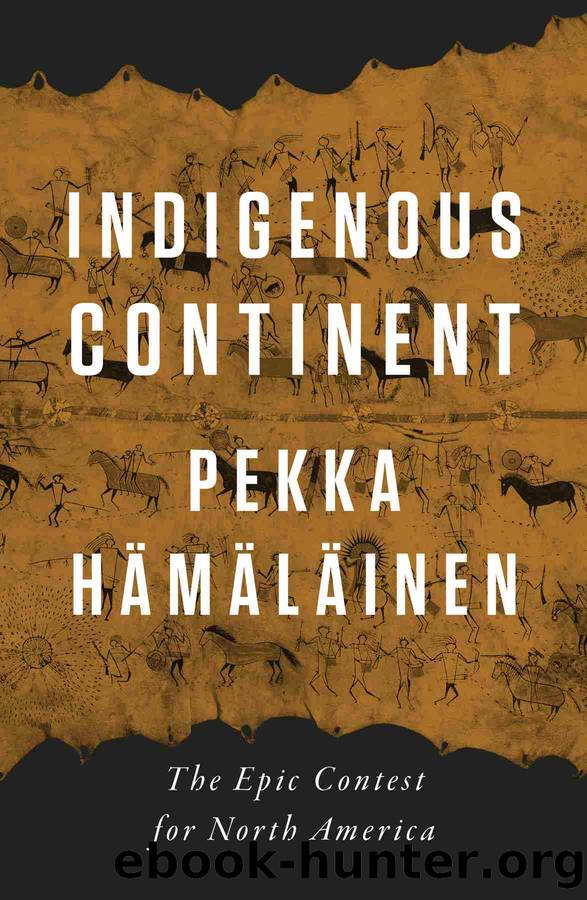Indigenous Continent by Pekka Hämäläinen

Author:Pekka Hämäläinen
Language: eng
Format: epub
Publisher: Liveright
Published: 2022-08-08T00:00:00+00:00
IN THE LATE EIGHTEENTH CENTURY, an ambiguous resistance movement emerged in the southern coastal plains. The powerful Muscogees had faced both external and internal challenges for years, and had become dangerously divided. Alexander McGillivray, the son of a high-status Muscogee mother and a Scots-Irish father, played a central role in the movement. He was wealthy, having amassed Black slaves and established a plantation near Muscogee towns. He had announced that âthe Crown of Spain will Gain and Secure a powerful barrier in these parts against ambitious and encroaching Americans.â To erect such a barrier, he maneuvered his way into the center of the Muscogee government by dominating the clan-based police force and the Muscogee National Council. A forceful and divisive figure, McGillivray was a student of natural history, a slave trader, and a skillful diplomat who had offered his services to both the British and the Spanish, privately promising the latter to keep the Muscogees subordinate to Spain. He worked as a silent partner for the formidable Scottish trading firm Panton, Leslie & Company, supplying munitions for Muscogee soldiers, while simultaneously using his Muscogee connections to boost his own influence: he was carving a personal colony out of the Muscogee Nation. McGillivray would eventually secure much of the Florida trade for Panton, Leslie & Company and, by extension, himself. He even stood out physically: unlike most Muscogee men, he did not have tattoos.7
Hoboithle MiccoââTallassee Kingâ to the Americansâopposed McGillivray, but he, too, operated outside the Muscogee National Council. Divided as they were, the Muscogees were vulnerable to land speculators and hostile colonial officials. In 1785, Georgia absorbed large tracts of the Muscogeesâ land in the Treaty of Galphinton, which was negotiated by Hoboithle. A year later, the Muscogees ceded an extensive strip of land to the colony, hoping to alleviate the pressure from land-hungry colonists. The tactic failed. Believing that the federal government would be less covetous of Muscogee lands than the Georgians had been, McGillivray decided to reach out to New York, which was at that time the seat of Congress. With a retinue of thirty Muscogees, he traveled east on a horse wagon and was feted, on the presidentâs orders, in every town along the way. McGillivray negotiated shrewdly, securing a duty-free port on the coast of Georgia, which gave him a de facto monopoly on Muscogee trade. By then, he had spent much of his political capital on his various schemes and had been rejected by many Muscogees. On his deathbed, McGillivray declared that he wanted to die as an Indian, but he left most of his possessions to his sons, violating traditional Muscogee inheritance customs.8
The United States had to treat Indigenous nations cautiously. Like the Americans, Native Americans had secured their independence from colonial aggression through war, and the Americans could not simply dictate terms to them, given their numbers and military power. Secure in their position, the Ohio Indians negotiated treaties with the American republic. The most consequential of them was the 1784 Treaty of
Download
This site does not store any files on its server. We only index and link to content provided by other sites. Please contact the content providers to delete copyright contents if any and email us, we'll remove relevant links or contents immediately.
| Americas | African Americans |
| Civil War | Colonial Period |
| Immigrants | Revolution & Founding |
| State & Local |
In Cold Blood by Truman Capote(3305)
Steve Jobs by Walter Isaacson(2830)
The Innovators: How a Group of Hackers, Geniuses, and Geeks Created the Digital Revolution by Walter Isaacson(2826)
All the President's Men by Carl Bernstein & Bob Woodward(2326)
Lonely Planet New York City by Lonely Planet(2169)
And the Band Played On by Randy Shilts(2127)
The Room Where It Happened by John Bolton;(2102)
The Poisoner's Handbook by Deborah Blum(2089)
The Murder of Marilyn Monroe by Jay Margolis(2055)
The Innovators by Walter Isaacson(2046)
Lincoln by David Herbert Donald(1943)
A Colony in a Nation by Chris Hayes(1880)
Under the Banner of Heaven: A Story of Violent Faith by Jon Krakauer(1745)
Amelia Earhart by Doris L. Rich(1645)
The Unsettlers by Mark Sundeen(1641)
Birdmen by Lawrence Goldstone(1618)
Dirt by Bill Buford(1609)
Being George Washington by Beck Glenn(1607)
Zeitoun by Dave Eggers(1586)
